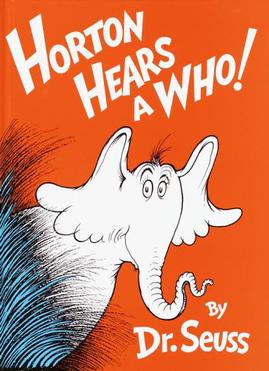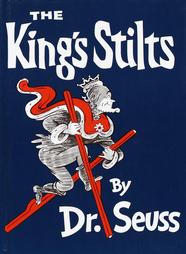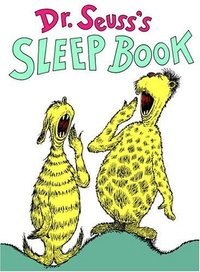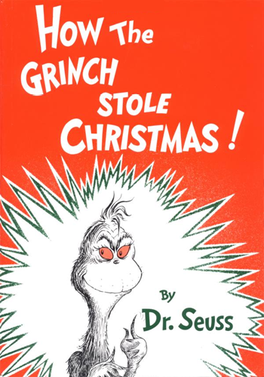Related Research Articles

Theodor Seuss Geisel was an American children's author and cartoonist. He is known for his work writing and illustrating more than 60 books under the pen name Dr. Seuss. His work includes many of the most popular children's books of all time, selling over 600 million copies and being translated into more than 20 languages by the time of his death.

The Cat in the Hat is a 1957 children's book written and illustrated by the American author Theodor Geisel, using the pen name Dr. Seuss. The story centers on a tall anthropomorphic cat who wears a red and white-striped top hat and a red bow tie. The Cat shows up at the house of Sally and her brother one rainy day when their mother is away. Despite the repeated objections of the children's fish, the Cat shows the children a few of his tricks in an attempt to entertain them. In the process, he and his companions, Thing One and Thing Two, wreck the house. As the children and the fish become more alarmed, the Cat produces a machine that he uses to clean everything up and disappears just before the children's mother comes home.

Horton Hears a Who! is a children's book written and illustrated by Theodor Seuss Geisel under the pen name Dr. Seuss. It was published in 1954 by Random House. This book tells the story of Horton the Elephant and his adventures saving Whoville, a tiny planet located on a speck of dust, from the animals who mock him. These animals attempt to steal and burn the speck of dust, so Horton goes to great lengths to save Whoville from being incinerated.

The Cat in the Hat Comes Back is a 1958 children's book written and illustrated by Dr. Seuss and published by Random House. In this book, a sequel to The Cat in the Hat (1957), the chaos-causing title character leaves a pink stain in the family bathtub, which spreads around the house as the children try to get rid of it, until the cat unveils a series of increasingly small cats from beneath his hat, the smallest of which resolves the problem.

The 500 Hats of Bartholomew Cubbins is a children's book, written and illustrated by Theodor Geisel under the pen name Dr. Seuss and published by Vanguard Press in 1938. Unlike the majority of Geisel's books, it is written in prose rather than rhyming and metered verse. Geisel, who collected hats, got the idea for the story on a commuter train from New York to New England, while he was sitting behind a businessman wearing a hat; the passenger was so stiff and formal that Geisel idly wondered what would happen if he took the man's hat and threw it out the window. Geisel concluded that the man was so "stuffy" that he would just grow a new one.

Horton Hatches the Egg is a children's book written and illustrated by Theodor Geisel under the pen name Dr. Seuss and published in 1940 by Random House. The book tells the story of Horton the Elephant, who is tricked into sitting on a bird's egg while its mother, Mayzie, takes a permanent vacation to Palm Beach. Horton endures a number of hardships but persists, often stating, "I meant what I said, and I said what I meant. An elephant's faithful, one hundred percent!" Ultimately, the egg hatches, revealing an elephant-bird, a creature with a blend of Mayzie's and Horton's features.

And to Think That I Saw It on Mulberry Street is Theodor Seuss Geisel's first children's book published under the pen name Dr. Seuss. First published by Vanguard Press in 1937, the story follows a boy named Marco, who describes a parade of imaginary people and vehicles traveling along a road, Mulberry Street, in an elaborate fantasy story he dreams up to tell his father at the end of his walk. However, when he arrives home, he decides instead to tell his father what he actually saw—a simple horse and wagon.

Yertle the Turtle and Other Stories is a picture book collection by Theodor Seuss Geisel, published under his more commonly known pseudonym of Dr. Seuss. It was first released by Random House Books on April 12, 1958, and is written in Seuss's trademark style, using a type of meter called anapestic tetrameter. Though it contains three short stories, it is mostly known for its first story, "Yertle the Turtle", in which the eponymous Yertle, king of the pond, stands on his subjects in an attempt to reach higher than the Moon—until the bottom turtle burps and he falls into the mud, ending his rule.

The King's Stilts is a children's book written and illustrated by Theodor Geisel, under the pen name Dr. Seuss, and first published in 1939 by Random House. Unlike many Dr. Seuss books, it is narrated in prose rather than verse.

McElligot's Pool is a children's book written and illustrated by Theodor Geisel under the pen name Dr. Seuss and published by Random House in 1947. In the story, a boy named Marco, who first appeared in Geisel's 1937 book And to Think That I Saw It on Mulberry Street, imagines a wide variety of fantastic fish that could be swimming in the pond in which he is fishing. It later became one of the Seuss books featured in the Broadway musical Seussical where its story is used for the song "It's Possible".

Dr. Seuss's Sleep Book, commonly referred to as The Sleep Book, is a children's book written by Dr. Seuss in 1962. The story centers on the activity of sleep as readers follow the journey of many different characters preparing to slip into a deep slumber. This book documents the different sleeping activities that some of the creatures join in on: Jo and Mo Redd-Zoff participate in competitive sleep talking and a group "near Finnigan Fen" enjoys group sleepwalking. It opens with a small bug, named Van Vleck, yawning. This single yawn sets off a chain reaction, effectively putting "ninety-nine zillion nine trillion and two" creatures to sleep.

Beginner Books is the Random House imprint for young children ages 3–9, co-founded by Phyllis Cerf with Ted Geisel, more often known as Dr. Seuss, and his wife Helen Palmer Geisel. Their first book was Dr. Seuss's The Cat in the Hat (1957), whose title character appears in the brand's logo. Cerf compiled a list of 379 words as the basic vocabulary for young readers, along with another 20 slightly harder "emergency" words. No more than 200 words were taken from that list to write The Cat in the Hat. Subsequent books in the series were modeled on the same requirement.
Helen Marion Palmer Geisel, known professionally as Helen Palmer, was an American children's writer, editor, and philanthropist. She was also the Founder and Vice President of Beginner Books, and was married to fellow writer Theodor Seuss Geisel, better known as Dr. Seuss, from 1927 until her death.

A Fish Out of Water is a 1961 American children's book written by Helen Palmer Geisel and illustrated by P. D. Eastman. The book is based on a short story by Palmer's husband Theodor Geisel, "Gustav, the Goldfish", which was published with his own illustrations in Redbook magazine in June 1950.
The Theodor Seuss Geisel Award is a literary award by the American Library Association (ALA) that annually recognizes the "author(s) and illustrator(s) of the most distinguished book for beginning readers published in English in the United States during the preceding year." The winner(s) receive a bronze medal at the ALA Annual Conference, presented by the Association for Library Service to Children (ALSC) division of ALA.

How the Grinch Stole Christmas! is a Christmas children's story by Theodor "Dr. Seuss" Geisel written in rhymed verse with illustrations by the author. It follows the Grinch, a grouchy, solitary creature who attempts to thwart the public's Christmas plans by stealing Christmas gifts and decorations from the homes of the nearby town of Whoville on Christmas Eve. Miraculously, the Grinch realizes that Christmas is not all about money and presents.

The Lorax is a 2012 American 3D computer-animated musical fantasy comedy film produced by Illumination Entertainment and distributed by Universal Pictures. The second screen adaptation of Dr. Seuss' 1971 children's book of the same name following the 1972 animated television special, the film was directed by Chris Renaud, co-directed by Kyle Balda, and produced by Chris Meledandri and Janet Healy, with Ken Daurio, Cinco Paul, and Seuss' widow Audrey Geisel serving as executive producers. Paul and Daurio also wrote the film’s screenplay. The film stars the voices of Danny DeVito, Ed Helms, Zac Efron, Taylor Swift, Rob Riggle, Jenny Slate, and Betty White. It builds on the book by expanding the story of the Lorax and Ted, the previously unnamed boy who visits the Once-ler.
Theodor Seuss Geisel, better known as Dr. Seuss, published over 60 children's books over the course of his long career. Though most were published under his well-known pseudonym, Dr. Seuss, he also authored over a dozen books as Theo. LeSieg and one as Rosetta Stone.

The political messages of Theodor Seuss Geisel, best known as Dr. Seuss, are found in many of his books. Geisel, a cartoonist and author for children, was also a liberal and a moralist who expressed his views in his books through the use of ridicule, satire, wordplay, nonsense words, and wild drawings to take aim at bullies, hypocrites, and demagogues.

Horse Museum is a Dr. Seuss book released by Random House Children's Books on September 3, 2019. It is based on an unfinished manuscript by Theodor Seuss Geisel completed by Australian illustrator Andrew Joyner. 250,000 copies were released of the first printing.
References
- 1 2 Smietana, Bob (March 20, 2004). "Dr. Seuss – theologian?". Religion News Service, cited at Seattle Times. Archived from the original on August 26, 2013. Retrieved August 26, 2013.
- ↑ Kemp, James W. (2004). The Gospel According to Dr. Seuss . Judson Press. ISBN 0-8170-1457-8.
- 1 2 3 Smith, John W. (June 5, 2004). "Minister mines Seuss for morals". Reading Eagle. Retrieved August 26, 2013.
- ↑ "Spiritual Dr. Seuss, paralyzed Lexington minister enjoys success of quirky religious book". Lexington Herald-Leader. March 4, 2004. Retrieved August 26, 2013.
- ↑ "Humor carreied him through funeral". Lexington Herald-Leader. December 30, 2006. Retrieved August 26, 2013.